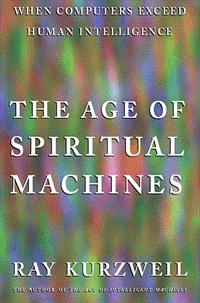This week’s lecture topic, Robotics + Art, is a topic that I
have personally taken great interest in. A few years ago, I read The Age of Spiritual Machines by Ray
Kurzweil, a non-fiction book that explains how technology is advancing at an exponential rate and predicts where technology will be by 2099.
The first portion of the book is dedicated to theory and the dense science
behind his predictions and the second portion is these predictions for 2009, 2019, 2029 and 2099. His predictions for 2009 include “short-distance
wireless technology” (Kurzweil 137), or what we call Bluetooth; that “books,
magazines, and newspapers are now routinely read on displays that are the size
of, well, small books” (138), what we call Kindles; and that “cybernetic music
creation systems allow people... [to] practice to create music in collaboration
with their automatic composition software” (141), something similar to
GarageBand.
His final predictions for 2099 and on are that “there is no longer
any clear distinction between humans and computers” and that these
human-machines will alter the fate of the Universe (212). He maps out the
social consequences of leaving our carbon-based bodies and making this
transformation into a conscious machine. Will some people choose to remain in
their carbon-based bodies? How can you protect your “mind file” from being
accessed, hacked, or altered? The book is terrifying and incredible all at
once.
Douglas Davis’s article, “The Work of Art in the Age of Digital
Reproduction” was written at the same time as The Age of Spiritual Machines, and expresses hope for a universal connectedness through
technology. The contrast between Kurzweil and Davis highlights two perceptions
of a growing technological world: one optimistic, one ominous. Walter Benjamin’s
article, “The Work of Art in the Age of Mechanical Reproduction,” touches on
technology integrating with art and the destructiveness that comes with it. Computers have already created art: they can draw, synthesize and create music, and can write puns (Kurzweil 115-116). Theoretically, computers will soon be leaders in the arts. Can computers be considered leaders if they aren't human? Will they be considered human? Benjamin quotes, “Fiat ars—pereat mundus,” or “Let art be created though the world be
perished” (Benjamin 7), a thought in line with Kurzweils’ final prediction,
leaving us wondering if computers will better our world or ultimately destroy
it.
REFERENCES
Asad, Taimur. iPad vs Kindle DX. Digital image. Redmond Pie. N.p., 28 Jan. 2010. Web. 19 Apr. 2015.
Benjamin, Walter. "The Work of Art in the Age of Mechanical Reproduction." (1936): 1-7. Web. 19 Apr. 2015.
Davis, Douglas. "The Work of Art in the Age of Digital Reproduction (An Evolving Thesis: 1991-1995)." Leonardo 28.5 (1995): 381-386. JSTOR. Web. 19 Apr. 2015.
Kurzweil, Raymond. The Age of Spiritual Machines: When Computers Exceed Human Intelligence. New York: Penguin, 2000. Print.
"Moore's Law." Moore's Law. Moore's Law, n.d. Web. 19 Apr. 2015.
Olson, Nikki. Age of Spiritual Machines Cover. Digital Image. Singularity, 2 Mar. 2011. Web. 19 Apr. 2015.
"Predictions Made by Ray Kurzweil." Wikipedia. Wikimedia Foundation, n.d. Web. 19 Apr. 2015.
"The Age of Spiritual Machines." Wikipedia. Wikimedia Foundation, n.d. Web. 19 Apr. 2015.
Virtual Reality Wallpaper. Digital image. Wallpapers Wide, n.d. Web. 19 Apr. 2015.



No comments:
Post a Comment